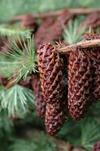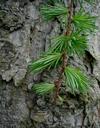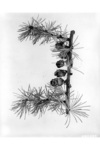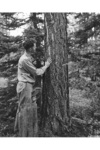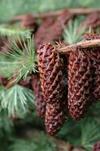Genus Larix
Larches are conifers in the genus Larix, in the family Pinaceae.Species in the genus Larix of plants
Larix czekanowskii - Larix × czekanowskii occurs where their ranges meet in central Siberia. It is intermediate between its parent species in all characters.
European larch - Larix decidua is a medium-size to large deciduous coniferous tree reaching 25-45 m tall, with a trunk up to 1 m diameter . The crown is conic when young, becoming broad with age; the main branches are level to upswept, with the side branches often pendulous. The shoots are dimorphic, with growth divided into long shoots and bearing several buds, and short shoots only 1-2 mm long with only a single bud. The leaves are needle-like, light green, 2-4 cm long which turn bright yellow before they fall in the autumn, leaving the pale yellow-buff shoots bare until the next spring.
Dahurian larch - Dahurian Larch, Larix gmelinii, is a species of larch native to eastern Siberia, and adjacent northeastern Mongolia, northeastern China and North Korea.
Sikkim larch - It is a medium-sized deciduous coniferous tree reaching 20-25 m tall, with a trunk up to 0.8 m diameter. The crown is slender conic; the main branches are level to upswept, the side branchlets pendulous from them. The shoots are dimorphic, with growth divided into long shoots and bearing several buds, and short shoots only 1-2 mm long with only a single bud. The leaves are needle-like, light glaucous green, 2-4 cm long; they turn bright yellow to orange before they fall in the autumn, leaving the pale yellow-brown shoots bare until the next spring.
Larix kaempferi - It is a medium-sized to large deciduous coniferous tree reaching 20-40 m tall, with a trunk up to 1 m diameter. The crown is broad conic; both the main branches and the side branches are level, the side branches only rarely drooping. The shoots are dimorphic, with growth divided into long shoots and bearing several buds, and short shoots only 1-2 mm long with only a single bud. The leaves are needle-like, light glaucous green, 2-5 cm long; they turn bright yellow to orange before they fall in the autumn, leaving the pinkish-brown shoots bare until the next spring.
Tamarack Larch - It is a small to medium-size deciduous coniferous tree reaching 10–20 metres tall, with a trunk up to 60 centimetres diameter. The bark is tight and flaky, pink, but under flaking bark it can appear reddish. The leaves are needle-like, 2–3 cm short, light blue-green, turning bright yellow before they fall in the autumn, leaving the pale pinkish-brown shoots bare until the next spring. The needles are produced spirally on long shoots and in dense clusters on short woody spur shoots. The cones are the smallest of any larch, only 1–2.3 cm long, with 12-25 seed scales; they are bright red, turning brown and opening to release the seeds when mature, 4–6 months after pollination.
Subalpine larch - Subalpine Larch is hardy and can survive very low temperatures in thin rocky soils, which is why the tree is often found near treeline. However, it can grow in a variety of soils and with or without shade, as long as the soil is moist but well-drained.
Masters's Larch - Larix mastersiana is a species of conifer in the Pinaceae family. It is found only in China. It is threatened by habitat loss.
Western larch - It is a large deciduous coniferous tree reaching 30–60 m tall, with a trunk up to 1.5 m diameter. The crown is narrow conic; the main branches are level to upswept, with the side branches often drooping. The shoots are dimorphic, with growth divided into long shoots and bearing several buds, and short shoots only 1–2 mm long with only a single bud. The leaves are needle-like, light green, 2–5 cm long, and very slender; they turn bright yellow in the fall, leaving the pale orange-brown shoots bare until the next spring.
Siberian larch - Larix russica



